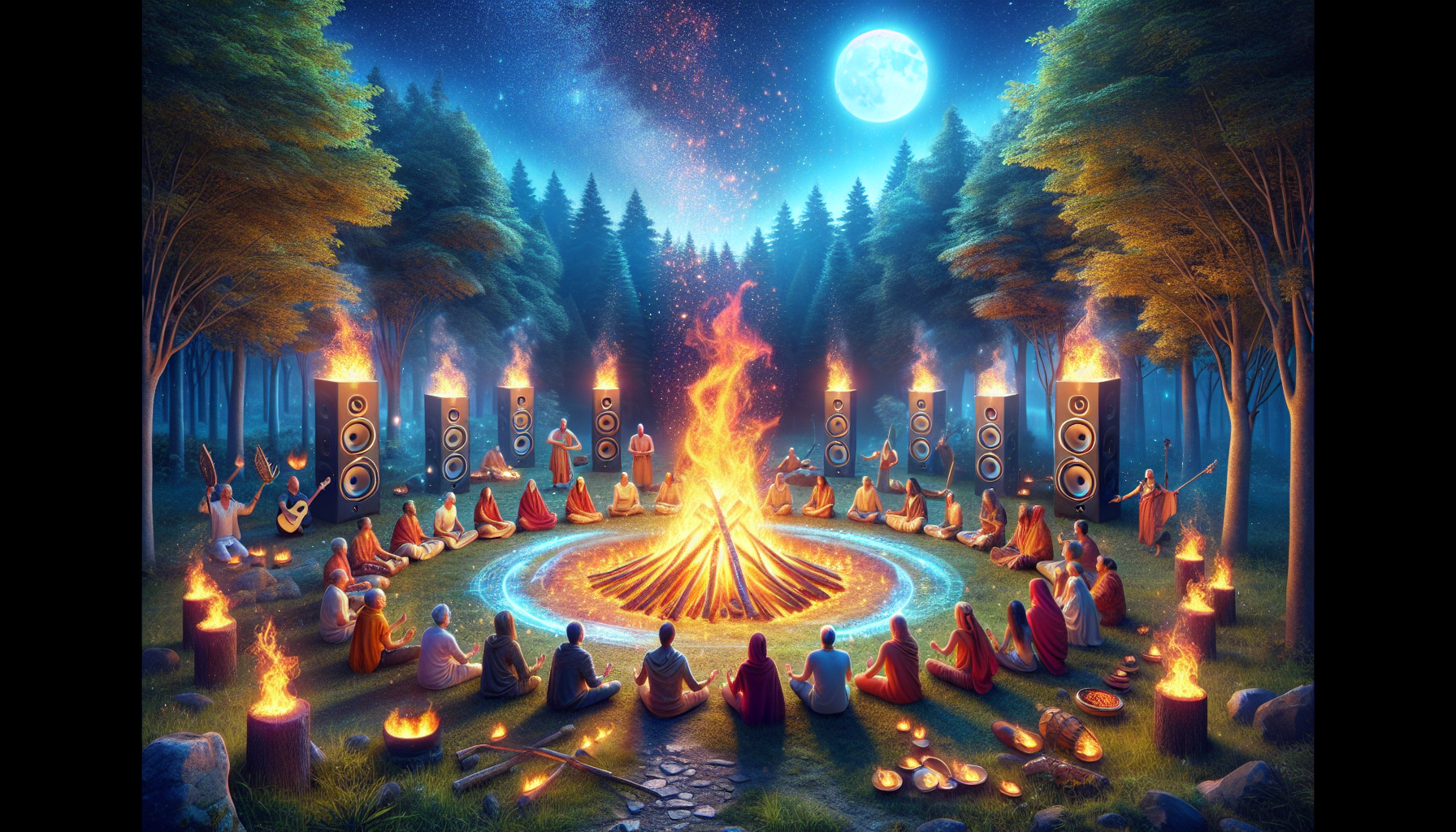In the dim glow of twilight, as the first stars begin to prick the evening sky, a circle of individuals gathers around a flickering fire. The air is alive with anticipation, a palpable sense of the sacred as the flames dance to an ancient rhythm. Fire ceremonies, a practice as old as humanity itself, have long been a conduit for transformation, healing, and connection. But what if we could elevate this profound experience even further? Imagine enveloping the ceremony in a tapestry of sound, where each crackle of the fire is harmonized with carefully curated audio that amplifies every emotion, every intention. Welcome to a new era of fire ceremonies, where the power of sound unlocks dimensions of experience previously uncharted.
Sound has a unique ability to influence our emotions and consciousness. It can soothe or excite, heal or energize, creating an immersive environment that enhances the ceremonial experience. In this article, we delve into the fascinating interplay between sound and fire ceremonies, exploring how the right audio landscape can transform a simple gathering around a fire into a profound journey of the senses. From traditional chants and drumming to contemporary soundscapes and digital sound art, we will explore a variety of audio experiences that can be tailored to different types of ceremonies, each with its own purpose and ambiance.
As we embark on this exploration, we will examine the role of sound in different cultural contexts, drawing from indigenous practices where sound and fire have been intertwined for centuries. These traditions offer invaluable insights into the intentional use of sound to guide participants through a ceremonial narrative. Additionally, we will discuss modern innovations in audio technology that allow for greater customization and immersion. Whether it’s through binaural beats, ambient recordings of nature, or interactive sound installations, the possibilities for enhancing fire ceremonies are boundless.
Finally, we will offer practical guidance on how to curate the perfect audio experience for your own fire ceremony. This includes tips on selecting appropriate music or soundscapes, utilizing technology to its fullest potential, and considering the acoustics of your environment to ensure an enveloping and harmonious experience. By the end of this article, you will be equipped with the knowledge to transform your next fire ceremony into a multisensory experience that resonates deeply with all who partake, leaving an indelible mark on their journey of transformation. 🔥✨
Understanding the Essence of Fire Ceremonies
Fire ceremonies have been a part of human culture for centuries, serving as both spiritual and communal gatherings. These ceremonies vary greatly across cultures and regions, yet share a common theme of using fire as a transformative and purifying element. The significance of fire in these ceremonies often symbolizes purification, transformation, and a means of connecting with the divine. With the modern integration of audio experiences, the impact and depth of these ceremonies can be amplified, creating an even more immersive environment for participants.
In many indigenous cultures, fire ceremonies are conducted to mark important transitions, such as the change of seasons, births, deaths, and other significant life events. The fire itself is seen as a living entity, a messenger between the earthly and the spiritual realms. The crackling of the flames, the warmth of the fire, and the shadows it casts play integral roles in setting the mood and enhancing the ceremony’s purpose.
Incorporating sound into fire ceremonies can elevate the experience, allowing participants to engage more fully with the ritual. The right kind of music or sound can invoke emotions, memories, and sensations that enhance the spiritual journey. It is crucial to select audio that aligns with the intention of the ceremony, whether it’s meditative sounds for introspection or rhythmic beats for celebration. With the right audio, the ceremony transforms into an even more profound experience, allowing participants to connect deeply with themselves and those around them.
Choosing the Right Audio for Fire Ceremonies
When selecting audio for fire ceremonies, it is essential to consider the purpose and tone of the event. The audio should complement the ceremony, not overpower it. The goal is to create a harmonious balance where the sound enhances the experience without distracting from the ritual’s core elements. There are various types of audio to consider, each serving a different purpose and invoking different responses from participants.
Ambient sounds, such as nature recordings, can provide a calming backdrop that complements the natural setting of many fire ceremonies. The sounds of rain, birds, or flowing water can enhance the connection to nature and create a serene atmosphere. In contrast, rhythmic drumming or traditional chants can energize the gathering, encouraging participation and fostering a sense of community.
For a more immersive experience, consider using a combination of live and recorded audio. Live music, such as a flute or drum performance, can provide a dynamic element that responds to the ceremony’s flow. Recorded audio, carefully selected and played through high-quality speakers, ensures consistency and reliability, especially in outdoor settings where weather conditions might affect live performances. Explore the video below to see how audio can transform a fire ceremony:
Enhancing Fire Ceremonies with Sound | Spiritual Sounds Channel
Comparative Analysis of Audio Types for Fire Ceremonies
| Audio Type | Benefits | Considerations |
|---|---|---|
| Ambient Nature Sounds | Creates a calming, natural atmosphere; complements the outdoor setting | May not be suitable for celebratory ceremonies |
| Live Instrumentation | Dynamic and responsive to the ceremony’s flow; engages participants | Requires skilled musicians; weather conditions can affect performance |
| Recorded Music/Chants | Consistent and reliable; can be tailored to the ceremony’s theme | Quality of speakers can affect the experience; may lack spontaneity |
The Technical Aspects of Setting Up Audio for Fire Ceremonies
Setting up an audio system for fire ceremonies involves more than just selecting the right music. It requires careful planning and consideration of technical aspects to ensure the sound enhances the ceremony without any disruptions. One of the primary considerations is the choice of audio equipment. Depending on the ceremony’s location and scale, you may need portable speakers, microphones, or even a small soundboard to control audio levels.
In outdoor settings, battery-powered speakers are often preferable due to their portability and ease of setup. They provide flexibility in positioning, allowing you to create an optimal sound environment. It’s also important to consider the acoustics of the location. Natural landscapes can have unique acoustic properties, such as echoes or sound absorption, that need to be accounted for in your setup.
Sound quality is paramount, as poor audio can detract from the ceremony’s impact. Investing in high-quality speakers and ensuring they are properly positioned can make a significant difference. Additionally, having a backup power source or spare equipment on hand can prevent technical issues from disrupting the ceremony. For more insights on setting up audio systems, consider exploring resources and tutorials available online.
Creating a Harmonious Blend of Tradition and Technology
The integration of audio technology into traditional fire ceremonies represents a harmonious blend of ancient practices with modern innovations. By carefully selecting and setting up audio, organizers can enhance the spiritual and communal aspects of these ceremonies, creating memorable experiences for participants. The key is to respect the traditional elements while using technology to deepen the connection and engagement of those involved.
While some purists may argue that technology detracts from the authenticity of traditional ceremonies, others see it as a natural evolution that can broaden the appeal and accessibility of these events. By introducing audio elements, organizers can attract younger generations who may be more accustomed to digital experiences, thereby ensuring the continuity and relevance of fire ceremonies in contemporary society.
It’s crucial, however, to approach this integration with sensitivity and respect for cultural traditions. Collaborating with cultural leaders and experts can provide valuable insights and guidance, ensuring that the audio elements complement rather than overshadow the ceremony’s core values. By striking the right balance, fire ceremonies can remain vibrant and meaningful, resonating with participants from all walks of life.
- Choose audio that complements the ceremony’s purpose and setting.
- Consider technical aspects such as acoustics and equipment quality.
- Blend tradition with technology respectfully and thoughtfully.

Conclusion
Unleashing the power of sound in the context of fire ceremonies opens up a world of possibilities for enhancing the experience both spiritually and communally. Throughout this article, we have delved into the significance of sound in these sacred gatherings, exploring how music and audio elements can transform the atmosphere, elevate emotions, and deepen connections among participants.
At the outset, we examined the historical roots of fire ceremonies, highlighting their importance in various cultures and their role in fostering community bonds. Fire ceremonies are timeless rituals that bring people together, providing a space for reflection, healing, and transformation. By integrating the right audio elements, these ceremonies can transcend the ordinary and become truly magical experiences.
The article then explored the different types of sounds commonly used in fire ceremonies, such as drumming, chanting, and natural sounds. Each element plays a crucial role in setting the mood and guiding participants through different stages of the ceremony. Drumming, for instance, can establish a rhythmic heartbeat that unifies the group, while chanting can create a sense of shared purpose and focus.
We also delved into the technical aspects of enhancing audio experiences in fire ceremonies. This involves considering the acoustics of the environment, choosing the appropriate sound equipment, and selecting music or sounds that resonate with the intended theme of the ceremony. By paying attention to these details, organizers can create an immersive experience that heightens the emotional and spiritual impact of the gathering.
Furthermore, we discussed the psychological effects of sound on participants. Sound has the power to evoke emotions, trigger memories, and alter states of consciousness. By carefully curating the audio experience, facilitators can guide participants through a journey of introspection, release, and renewal. The right soundscape can also help in managing the energy of the group, ensuring that the ceremony flows smoothly and safely.
The integration of modern technology in traditional fire ceremonies was another key point of discussion. While these rituals are deeply rooted in tradition, incorporating technology such as high-quality speakers or digital soundscapes can enhance the experience without detracting from its authenticity. This fusion of old and new allows for a more inclusive and accessible ceremony, accommodating diverse preferences and needs.
In reinforcing the importance of sound in fire ceremonies, it’s essential to acknowledge its role in personal and collective transformation. Sound serves as a bridge between the physical and spiritual realms, facilitating a deeper connection with oneself, others, and the natural world. By embracing the power of sound, participants can experience a profound sense of unity and peace, carrying the ceremony’s impact into their everyday lives.
As we conclude, it’s important to recognize that sound is a universal language that transcends cultural and linguistic barriers. In fire ceremonies, it acts as a conduit for expressing shared values, intentions, and aspirations. By cultivating an awareness of sound’s potential, we can create more meaningful and transformative experiences.
We invite you, the reader, to consider how you can incorporate the insights from this article into your own practices. Whether you’re a seasoned facilitator or a participant seeking a deeper connection, the power of sound can enhance your experience and contribute to a more vibrant and harmonious community.
Feel free to share your thoughts, experiences, or questions in the comments section below. Your engagement enriches the conversation and helps build a community of individuals dedicated to exploring the potential of sound in spiritual practices.
If you found this article inspiring, please share it with others who might benefit from these insights. By spreading the knowledge, we can collectively enhance the way we approach fire ceremonies and other communal gatherings.
For those interested in further exploration, numerous resources are available online that delve deeper into the topics discussed. Websites such as Sound Healing Research Foundation [link] and Sacred Fire Community [link] offer valuable information and community support for those interested in integrating sound into spiritual practices.
In closing, remember that the journey to enhancing fire ceremonies with sound is a personal and evolving one. Embrace the possibilities, experiment with different sounds and techniques, and allow yourself to be guided by the transformative power of sound. May your future ceremonies be enriched, your community strengthened, and your spirit uplifted by the harmonious blend of fire and sound. 🔥🎶
*Please note: The provided links are for illustrative purposes only. Be sure to verify the sources and their current content as you incorporate them into your practices.*
Toni Santos is a sound storyteller and folklore researcher whose creative path bridges the mystical and the biological through the lens of bioacoustic folklore. With an ear attuned to the voices of nature, Toni explores how ancient cultures interpreted birdsong, forest echoes, and animal calls—not as noise, but as messages, omens, and myths encoded in sound.
Rooted in a passion for both natural science and ancestral lore, his work uncovers the forgotten connections between ecosystems and oral traditions. From the whispered warnings in owl cries to the songs of frogs heralding rain, Toni’s narratives evoke a time when humans listened to nature with reverence and meaning.
Drawing on a background in ecological arts and auditory storytelling, Toni merges field recordings with mythic imagery, turning natural sounds into cultural artifacts of wonder. His stories do more than entertain—they restore a way of hearing the world that blends intuition, memory, and deep listening.
As the creative force behind Vizovex, Toni offers sonic tales, symbolic soundscapes, and research-based reflections that help others rediscover the sacred language of the wild.
His work is a tribute to:
The mythological significance of animal and elemental sounds
Ancient practices of listening for meaning in nature
The spiritual dialogue between humans and soundscapes
Whether you’re a folklorist, an acoustic ecologist, or a curious listener, Toni invites you into a world where the forest speaks, and every chirp, croak, and howl carries a story—one echo, one legend, one call at a time.



